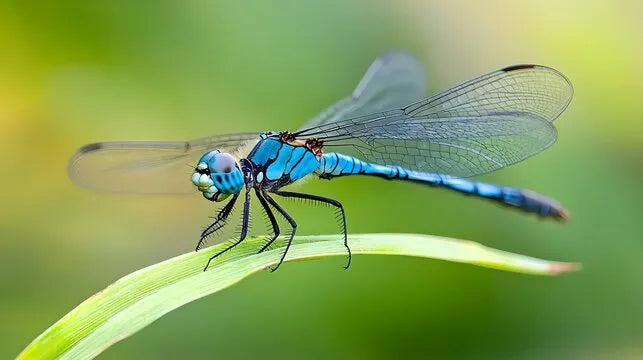
Everything You Need to Know About Dragonflies: From Prehistoric Predators to Modern Marvels
Share
Introduction
Dragonflies are some of the most fascinating creatures in the natural world. With their shimmering wings, giant eyes, and acrobatic flight, they seem like magical beings plucked straight from a fantasy story. But these insects aren’t just beautiful they're ancient, efficient hunters with a life story that’s as dramatic as it is unique.
In this post, we’ll dive into the complete world of dragonflies exploring their origins from the age of giants, their unusual underwater youth, their transformation into sky-hunters, and their important role in nature.
Ancient History: Dragonflies Before the Dinosaurs
Dragonflies are among the oldest known insects on Earth, with fossil records dating back over 300 million years. They appeared long before birds, mammals, and even dinosaurs. Back then, their ancestors called griffinflies ruled the skies. Some of these prehistoric dragonflies had wingspans of over 2 feet (70 cm), making them some of the largest flying insects to ever exist.
Why were they so big? The Earth's atmosphere during the Carboniferous period had higher oxygen levels, allowing insects to grow much larger than they can today.
Despite shrinking in size, modern dragonflies have kept many of the same traits as their ancient ancestors especially their wing structure and incredible flying ability earning them the nickname "living fossils."
Dragonfly Anatomy: Built for the Hunt
-
Eyes: Dragonflies have some of the best vision in the insect world. Their compound eyes contain up to 30,000 tiny lenses, giving them a nearly 360-degree field of vision.
-
Wings: They have two pairs of strong, transparent wings that move independently, allowing for advanced aerial maneuvers like hovering, backward flying, and sharp turns.
-
Body: Their long, slender abdomen helps with balance and agility in the air.
-
Legs: They can’t walk well, but their spiny legs form a “basket” to scoop up prey in flight.
Life Cycle: From Water-Dweller to Sky Dancer
The dragonfly's life cycle is one of nature’s most dramatic transformations. They go through incomplete metamorphosis, which includes three main stages: egg, nymph, and adult.

Stage 1: Egg
After mating, the female lays eggs either in water or on aquatic plants. Depending on the species, eggs hatch within days or weeks.
Stage 2: Nymph (Larva Stage)
This is the longest part of a dragonfly’s life lasting from several months to several years.
-
Dragonfly nymphs live underwater and are fierce aquatic predators.
-
They feed on mosquito larvae, tadpoles, small fish, and even other nymphs.
-
Nymphs breathe through gills located in their rectum and can shoot water jets from the same area to propel themselves forward like tiny underwater torpedoes.
-
They molt multiple times as they grow.
Stage 3: Molting and Adult Dragonfly
When fully grown, the nymph climbs out of the water onto a rock or plant. There, it begins its final molt:
-
The skin splits open, and the adult dragonfly emerges slowly, unfolding its wings and drying out its body.
-
Once ready, the adult takes flight. This marks the beginning of the shortest stage of its life usually just a few weeks to a few months.
Dragonfly Hunting: Precision Predators
Adult dragonflies are aerial hunters, catching and eating prey mid-air with incredible accuracy. Their prey includes:
-
Mosquitoes
-
Flies
-
Moths
-
Bees
-
Butterflies
-
Gnats
They use their sharp eyesight, powerful wings, and fast reflexes to intercept prey, often grabbing it mid-flight and eating it on the go. Studies have shown that dragonflies have a hunting success rate of up to 95%, making them one of the most efficient predators on the planet.
Role in the Ecosystem
Dragonflies play a crucial role in nature:
-
They control insect populations, especially mosquitoes.
-
Their presence indicates a healthy freshwater ecosystem.
-
Dragonfly nymphs are a food source for fish, frogs, and birds.
They’re also pollinators, though not as efficient as bees, and help maintain biodiversity in wetland ecosystems.
Fun Facts About Dragonflies
-
There are over 5,000 species of dragonflies worldwide.
-
Some species can fly at speeds of up to 30 miles per hour (48 km/h).
-
In Japanese culture, dragonflies symbolize strength, courage, and happiness.
-
In some Native American traditions, they represent transformation and change.
-
Unlike butterflies, dragonflies do not have a pupal (chrysalis) stage.
Conclusion: More Than Just a Summer Sight
Dragonflies are not only stunning to look at they are ancient survivors, agile hunters, and essential parts of healthy ecosystems. From their secret underwater lives to their powerful flights through the air, every stage of a dragonfly’s existence is a marvel of adaptation and evolution.
So next time you see one gliding over a pond or zipping through your garden, take a moment to appreciate the incredible journey it has made from prehistoric times to your backyard.
